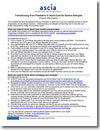Rite of passage - with an extra challenge
April 2014
Anaphylaxis is a potentially life-threatening allergic reaction that requires urgent medical treatment. It is therefore essential to know how to recognise and respond to an anaphylaxis emergency as well as implement appropriate risk minimisation strategies to prevent exposure to known allergens.
Teenagers and young adults have been identified as a high risk group for fatal anaphylaxis (1-3). It is precisely when they are becoming more independent, that they need to build the skills required to manage their severe allergies as well as know how to access their health professionals.
Sadly, there are still deaths from anaphylaxis, many of which are preventable. Severe allergic reactions can occur at schools or in new surroundings, or as teenagers grow into adults, learning how to be independent and take increasing responsibility for managing their allergies.
An excellent segment was presented on the ABC’s 7.30 Report earlier this year about the difficulties adolescents face when venturing out on school excursions and, later, learning to be responsible for their own health on social occasions.
To view this report by Adam Harvey, go to: www.abc.net.au/7.30/content/2013/s3919912.htm
For information on the correct treatment of anaphylaxis see the ASCIA website www.allergy.org.au/health-professionals/anaphylaxis-resources/first-aid-for-anaphylaxis
 ASCIA acknowledges that teenagers may need some guidance in transitioning from paediatric to adult care and as a result has produced an important new document for patients called Transitioning from Paediatric to Adult Care for Severe Allergies.
ASCIA acknowledges that teenagers may need some guidance in transitioning from paediatric to adult care and as a result has produced an important new document for patients called Transitioning from Paediatric to Adult Care for Severe Allergies.
Go to www.allergy.org.au/patients/allergy-treatment/transitioning-from-paediatric-to-adult-care to view.
References
1. Bock SA. Fatal Anaphylaxis. UpToDate. 2010.
2. Bock SA. Further fatalities, caused by anaphylactic reactions to food, 2001-2006. JACI 2007; 119 (4): 106-1018 (Letter to the editor).
3. Bock SA et al. Fatalities due to anaphylactic reactions to foods. JACI 2001; 107 (1): 191
